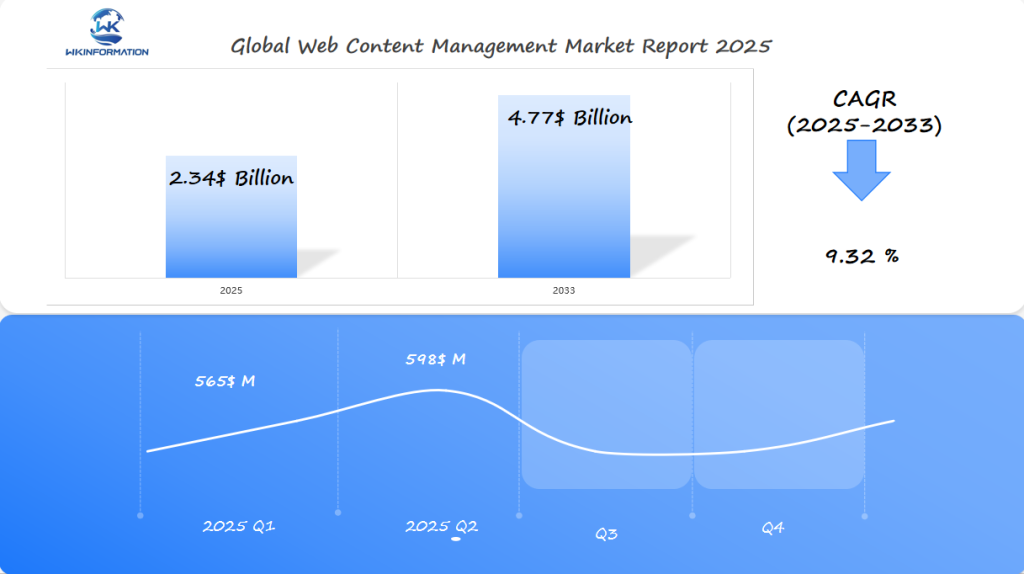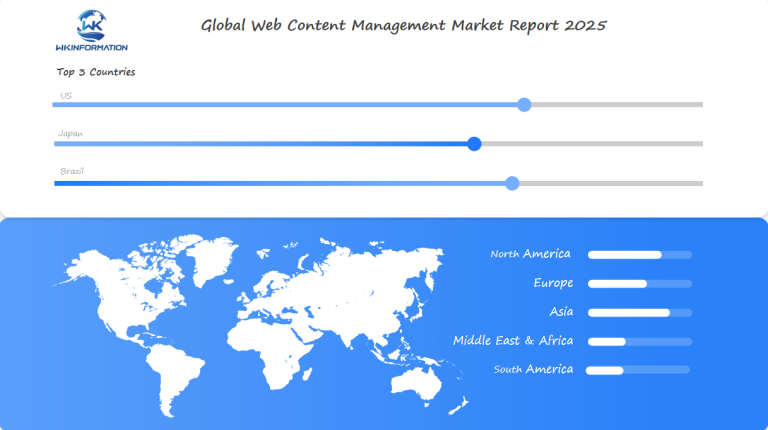Web Content Management Market Expected to Surpass $2.34 Billion Globally by 2025: Rapid Digital Expansion in the U.S., Japan, and Brazil
Discover how the Web Content Management Market is revolutionizing digital experiences, driving enterprise growth, and shaping content delivery across industries through 2025.
- Last Updated:
Web Content Management Market in Q1 and Q2 of 2025
The Web Content Management (WCM) market is set to reach $2.34 billion by 2025, expanding at a CAGR of 9.32% through 2033. Q1 sales are estimated at $565 million, with Q2 expected to reach $598 million. In the U.S., businesses across e-commerce, media, and education are prioritizing scalable WCM platforms to enable omnichannel digital strategies. Japan is accelerating adoption through smart city initiatives and localized CMS integrations for public sector websites. In Brazil, a surge in digital marketing and mobile-first audiences is pushing demand for flexible, cloud-based systems.

Key Takeaways
- Web Content Management Market projected to reach $2.34 billion by 2025
- Digital transformation driving content management system adoption
- Advanced platforms enabling omnichannel content strategies
- Increasing demand for flexible and scalable digital solutions
- Content management systems critical for modern business operations
Understanding the Web Content Management (WCM) Ecosystem
The Web Content Management (WCM) ecosystem is a complex network that connects various players in the digital publishing and content creation industries. This landscape encompasses everything from content creation to online sharing.
Key Players in the WCM Ecosystem
The following are the key players involved in the WCM ecosystem:
- Software providers developing content management platforms
- Content creators generating digital assets
- Marketing professionals strategizing content distribution
- End-users consuming digital content
Each part of this industry chain plays a crucial role in the content process. With the advent of new technologies, the way we manage and share content continues to evolve.
Stages of the WCM Ecosystem
The WCM ecosystem can be divided into three stages: upstream, midstream, and downstream. Each stage has its own key players and primary functions.
| WCM Ecosystem Stage | Key Players | Primary Functions |
| Upstream | Content Creators | Generate original digital content |
| Midstream | Content Management Platforms | Organize, edit, and optimize content |
| Downstream | Distribution Channels | Publish content across multiple platforms |
Importance of Understanding the WCM Ecosystem
It is essential for companies to understand the intricacies of the WCM ecosystem. By aligning strategies across different stages, businesses can create seamless digital content experiences for their audiences.
Emerging trends in headless CMS, personalization, and omnichannel delivery
The digital world is changing fast. New technologies are changing how we manage and share content. Today’s businesses are using new ways to be flexible, personal, and easy to use on many platforms.
The Rise of Headless CMS Architecture
Headless CMS is a big change in content management. It uses an API-first approach. This means content can be used in many ways without being tied to one place.
- Enables rapid content deployment across multiple channels
- Supports complex digital experiences
- Provides enhanced scalability and performance
Advancements in Content Personalization
Content personalization is getting better. Companies use smart algorithms and machine learning. They make content that really speaks to each user.
| Personalization Strategy | Key Benefits |
| Behavioral Targeting | Increased user engagement |
| Dynamic Content Adaptation | Improved conversion rates |
| Predictive Recommendations | Enhanced user satisfaction |
Omnichannel Content Delivery Strategies
Today, companies focus on delivering content everywhere. They want to make sure content is the same everywhere. This helps brands stay consistent and reach users in many ways.
Challenges in integration, scalability, and content governance
Companies using Web Content Management (WCM) face big technical and strategic hurdles. These challenges can really affect how they manage digital content. Integrating WCM systems is complex and needs careful planning.
Some major challenges in WCM include:
- Scalability issues when content grows a lot
- Integrating with existing systems is hard
- Keeping content governance strong across platforms
- Protecting data in a wide content network
Scalability issues
Scalability is a big problem for growing companies. Digital teams must build WCM systems that can grow with content. They need to keep performance and user experience high.
Content governance
Content governance needs smart strategies. These strategies must balance following rules with creative freedom. Companies need strong systems for content creation, approval, and publishing across teams.
Data security
Data security is very important in WCM. Companies must have strong security to protect data. They also need to make sure content can be shared and worked on easily.
New technologies and better integration methods help solve old WCM problems. Adaptive platforms offer smarter, more flexible ways to manage content. They tackle scalability, governance, and security all at once.

Geopolitical influences on cloud hosting and data jurisdiction
The world of cloud hosting has changed a lot because of complex rules about data. Companies now face big challenges when dealing with data rules in different places. They must think about GDPR and other rules when planning their online content.
Important things to think about in today’s world include:
- Understanding regional data protection laws
- Implementing robust data localization strategies
- Ensuring transparent data transfer mechanisms
- Protecting user privacy across international platforms
Data sovereignty is a big worry for companies growing online. They need to pick cloud hosting services that follow all the global data rules. This way, they avoid legal problems and keep their data safe.
The rules about data are always changing. Proactive compliance with GDPR and other global rules is now a must for online businesses.
New markets are making strict rules about data, making companies change how they manage their online content. They need to use advanced technology that can keep up with changing rules. This helps them keep their sites running well and users happy.
Product segmentation of Web Content Management by architecture and features
The Web Content Management (WCM) market has many architectural solutions. These meet different needs of organizations. You can choose from on-premises solutions, cloud-based WCM, and hybrid WCM systems.
On-Premises Solutions
On-premises solutions give businesses full control over their content management. They keep data in their own network. This ensures top security and customization. Companies needing strict compliance often choose this.
Cloud-Based WCM
Cloud-based WCM is more flexible and scalable. It offers:
- Rapid deployment
- Lower initial investment
- Automatic updates
- Enhanced accessibility
Hybrid WCM Systems
Hybrid WCM systems offer the best of both worlds. They mix on-premises and cloud-based architectures. This lets organizations use cloud flexibility while keeping important data on local servers.
Modern WCM products have key features. These include:
- AI-powered content analytics
- Multi-language support
- Advanced workflow management
- Personalization capabilities
Choosing the right WCM architecture depends on your digital content strategy. It also depends on scalability and security needs.
Application segmentation spanning e-commerce, media, and government platforms
Web Content Management (WCM) systems have transformed digital experiences across various sectors by providing tailored solutions to meet specific requirements. One area that has witnessed significant evolution is e-commerce, where WCM systems empower businesses to craft vibrant online platforms.
1. E-commerce
In the realm of e-commerce, WCM systems play a crucial role in:
- Simplifying the management of product descriptions
- Crafting personalized experiences for customers
- Ensuring content optimization across all devices
2. Media
Media content platforms leverage sophisticated WCM systems to streamline their digital workflows. This enables journalists and creators to:
- Efficiently handle large volumes of digital assets
- Publish content simultaneously across multiple channels
- Adhere to stringent content guidelines
3. Government
Government digital services utilize WCM as a means to enhance their engagement with citizens. These platforms assist public sector entities in:
- Promoting transparency by making information more accessible
- Designing user-centric digital interfaces
- Standardizing the dissemination of information
The diverse applications of WCM in these sectors highlight its versatility and significance in the contemporary digital landscape.
Regional development in the global Web Content Management market
The global Web Content Management (WCM) market shows big differences in different areas. Each region has its own digital plans and tech level. In places like North America and Western Europe, innovation is key. But, in Asia-Pacific and Latin America, WCM use is growing fast.
Regional adoption rates show different trends in the global WCM market:
- North America leads with advanced digital infrastructure
- Europe shows steady growth in enterprise content management
- Asia-Pacific emerges as a high-potential market for WCM solutions
- Developing regions demonstrate increasing digital transformation investments
Emerging markets are growing fast in WCM tech. Countries like India, Brazil, and China are making big digital investments. This is making content management platforms more popular in many areas. These places offer great chances for WCM companies to grow beyond usual markets.
The competition changes by area, with local players competing with big WCM brands. Localization and cultural adaptation are key to success in these markets.

U.S. enterprise digital strategies accelerating WCM adoption
The U.S. digital transformation is changing fast. Companies in many industries are now using digital experience platforms. They want to make their online presence better and connect with customers more effectively.
What’s driving this change?
A few main things:
- More people want digital experiences that feel personal.
- Companies need to deliver content smoothly across all channels.
- Handling digital customer interactions is getting more complex.
Businesses are spending a lot on WCM solutions
They look for:
- Tools that manage content well.
- Systems that track performance in real-time.
- Cloud-based options that can grow with them.
Financial services, healthcare, and tech are leading in WCM adoption. They see how good digital content management can boost customer happiness and work efficiency.
The move towards headless CMS and AI in content is big. Companies want solutions that are flexible and can keep up with digital changes.
Japan's demand for multilingual and mobile-first content systems
The Japanese WCM market is leading in digital innovation. It’s changing how we manage multilingual content with mobile-first strategies. Businesses in Japan are quickly updating their online presence to reach both global and local audiences.
What’s driving this change? A few key factors:
- Advanced mobile technology penetration
- Growing international business interactions
- Complex linguistic content requirements
Japanese companies know how vital it is to offer smooth multilingual content experiences. Their focus on mobile-first strategies has led to web content management platforms that easily switch between languages.
The Japanese WCM market shows great flexibility in content management. Companies are spending a lot on technologies that support:
- Real-time translation capabilities
- Responsive mobile design
- Intelligent content personalization
These advancements show Japan’s dedication to creating dynamic, accessible digital experiences. They aim to connect with people from different cultures.
Brazil's Digital Transformation and Regional CMS Market Growth
The Brazilian Web Content Management market is growing fast. This growth is pushing digital transformation in Latin America across many sectors. New chances are changing how companies handle digital content in the area.
Why Is Brazil’s Digital Transformation Happening So Fast?
Digital change in Brazil has sped up a lot. This has made a big need for better Web Content Management (WCM) solutions. Important industries are spending a lot to update their digital setups. They see how important it is to have content management systems that can adapt.
Some key industries driving this demand include:
- E-commerce platforms seeking localized content experiences
- Financial institutions modernizing digital interfaces
- Government agencies implementing digital citizen services
How Are Brazilian Companies Adapting?
Brazilian companies are now using advanced WCM technologies. These technologies help with:
- Multilingual content delivery
- Mobile-responsive design
- Personalized user experiences
What Are the Challenges and Opportunities?
The digital transformation in Latin America brings both challenges and chances. Local WCM providers are making solutions that meet specific regional needs. They focus on working with local tech and following local data rules.
What Does This Mean for Investors?
There are big chances in the Brazilian WCM market for international tech investments. This shows strong potential for more digital innovation and growth in the future.
Future trajectory driven by AI integration and low-code platforms
The Web Content Management (WCM) world is changing fast. This is thanks to artificial intelligence and low-code platforms. AI-powered WCM is making it easier for companies to manage their digital content.
Some big changes in WCM include:
- Advanced content automation using predictive analytics
- Intelligentcontent personalization thanks to machine learning
- AI-driven insights for better workflow management
Low-code platforms are making content management easier for everyone. They let non-tech teams create digital experiences fast. These platforms make it simpler to start digital projects.
Predictive analytics are becoming key in WCM. They help companies:
- Improve content performance
- Understand user behavior
- Make content strategies that really work
The mix of AI and low-code is changing how we manage content. It’s making systems that are smart and can keep up with the fast pace of the digital world.
Leading vendors and competition in the Web Content Management space
Key players in the web content management market are focusing on AI-driven personalization, omnichannel publishing, and seamless integration with marketing automation tools to help organizations deliver dynamic digital experiences. They are expanding their presence in rapidly digitizing regions such as Asia-Pacific and the Middle East, where businesses are accelerating their online transformation. By partnering with cloud service providers and investing in scalable, headless CMS platforms, these companies are enhancing their product offerings and driving the next wave of innovation in digital content strategy and customer engagement.
Key Players:
-
Adobe Experience Manager (United States)
-
Sitecore (Denmark)
-
WordPress VIP (United States)
-
Acquia (United States)
-
Kentico (Czech Republic)
-
Episerver (Optimizely) (Sweden / United States)
-
Magnolia (Switzerland)
-
Crownpeak (United States)
-
Liferay (United States)
-
Contentful (Germany)
Overall
| Report Metric | Details |
|---|---|
| Report Name | Global Web Content Management Market Report |
| Base Year | 2024 |
|
Segment by Type |
· On-premises Solutions · Cloud-based WCM · Hybrid WCM Systems |
| Segment by Application |
· E-commerce · Media · Government Platforms |
| Geographies Covered |
· North America (United States, Canada) · Europe (Germany, France, UK, Italy, Russia) · Asia-Pacific (China, Japan, South Korea, Taiwan) · Southeast Asia (India) · Latin America (Mexico, Brazil) |
| Forecast units | USD million in value |
| Report coverage | Revenue and volume forecast, company share, competitive landscape, growth factors and trends |
Global Web Content Management Market Report (Can Read by Free sample) – Table of Contents
Chapter 1: Web Content Management Market Analysis Overview
- Competitive Forces Analysis (Porter’s Five Forces)
- Strategic Growth Assessment (Ansoff Matrix)
- Industry Value Chain Insights
- Regional Trends and Key Market Drivers
- Web Content Management Market Segmentation Overview
Chapter 2: Competitive Landscape
- Global Web Content Management Players and Regional Insights
- Key Players and Market Share Analysis
- Sales Trends of Leading Companies
- Year-on-Year Performance Insights
- Competitive Strategies and Market Positioning
- Key Differentiators and Strategic Moves
Chapter 3: Web Content Management Market Segmentation Analysis
- Key Data and Visual Insights
- Trends, Growth Rates, and Drivers
- Segment Dynamics and Insights
- Detailed Market Analysis by Segment
Chapter 4: Regional Market Performance
- Consumer Trends by Region
- Historical Data and Growth Forecasts
- Regional Growth Factors
- Economic, Demographic, and Technological Impacts
- Challenges and Opportunities in Key Regions
- Regional Trends and Market Shifts
- Key Cities and High-Demand Areas
Chapter 5: Web Content Management Emerging and Untapped Markets
- Growth Potential in Secondary Regions
- Trends, Challenges, and Opportunities
Chapter 6: Product and Application Segmentation
- Product Types and Innovation Trends
- Application-Based Market Insights
Chapter 7: Web Content Management Consumer Insights
- Demographics and Buying Behaviors
- TargetAudience Profiles
Chapter 8: Key Findings and Recommendations
- Summary of Web Content Management Market Insights
- Actionable Recommendations for Stakeholders

Access the study in MULTIPLEFORMATS
Didn’t find what you’re looking for?
TALK TO OUR ANALYST TEAM
Need something within your budget?
NO WORRIES! WE GOT YOU COVERED!
Call us on: +1-866-739-3133
Email: infor@wkinformation.com
What is Web Content Management (WCM) and why is it important?
Web Content Management helps organizations manage digital content on different platforms. It’s key for businesses to create content easily, improve user experience, and keep a consistent online presence.
How is the Web Content Management market expected to grow?
The WCM market is set to grow over $2.34 billion by 2025. This growth is driven by digital transformation and the need for better content management.
What are the key types of Web Content Management systems?
There are three main types: on-premises, cloud-based, and hybrid. Cloud-based systems are popular for their flexibility and scalability.
What is a headless CMS?
A headless CMS separates content management from the presentation layer. This allows content to be delivered across various platforms efficiently.
How do geopolitical factors impact Web Content Management?
Geopolitical factors like data sovereignty laws and GDPR compliance affect WCM. Companies must navigate these laws when implementing content strategies.
Which industries benefit the most from Web Content Management solutions?
Industries such as e-commerce, media, and healthcare gain significant advantages from WCM. It enhances content delivery and user experiences.
How is AI changing Web Content Management?
AI is transforming WCM by enabling personalized content and automated creation. It also improves user experience and analytics.
What are the main challenges in implementing a WCM system?
Challenges include system integration, scalability, and content governance. Data security and managing multi-channel content are also concerns.
How do regional markets differ in WCM adoption?
Markets in North America, Europe, and Asia-Pacific have different adoption levels. Japan, for example, focuses on multilingual and mobile content.
What is the role of low-code platforms in Web Content Management?
Low-code platforms make content management easier. They allow non-technical users to create and manage content quickly.

